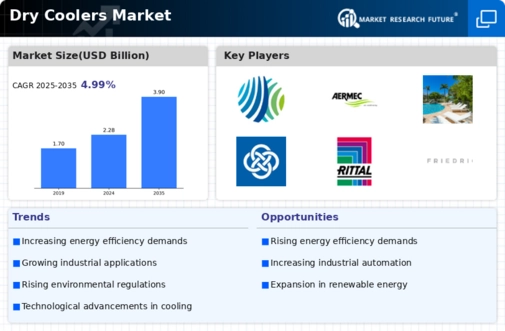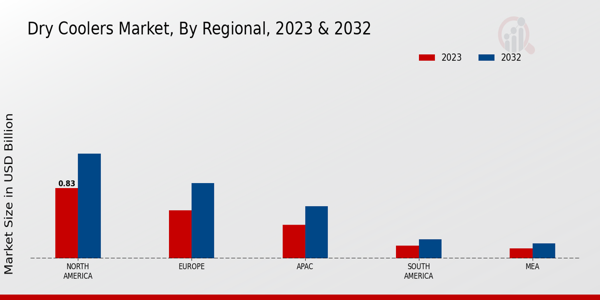Market Growth Projections
The Global Dry Coolers Market Industry is poised for substantial growth, with projections indicating a market value of 2.28 USD Billion in 2024 and an anticipated increase to 3.9 USD Billion by 2035. This growth trajectory reflects a compound annual growth rate of 4.99% from 2025 to 2035. The increasing adoption of dry cooling technologies across various sectors, driven by energy efficiency and sustainability considerations, underpins these projections. As industries continue to prioritize efficient cooling solutions, the market is likely to expand, presenting opportunities for innovation and investment in dry cooler technologies.
Growth in Industrial Applications
The Global Dry Coolers Market Industry is significantly influenced by the expansion of industrial applications. Industries such as pharmaceuticals, food and beverage, and chemical processing are increasingly utilizing dry coolers for temperature control and process cooling. This trend is driven by the need for reliable and efficient cooling systems that can operate in various environmental conditions. As industrial sectors continue to expand globally, the demand for dry coolers is expected to rise, contributing to a compound annual growth rate of 4.99% from 2025 to 2035. This growth reflects the essential role of dry coolers in maintaining optimal operational conditions across diverse industries.
Rising Demand for Energy Efficiency
The Global Dry Coolers Market Industry experiences a notable surge in demand for energy-efficient cooling solutions. Industries are increasingly adopting dry coolers to reduce energy consumption and operational costs. This trend is particularly evident in sectors such as manufacturing and data centers, where energy efficiency is paramount. As organizations strive to meet sustainability goals, the adoption of dry coolers is projected to contribute to the market's growth, with an estimated value of 2.28 USD Billion in 2024. The emphasis on energy efficiency aligns with global initiatives aimed at reducing carbon footprints, further driving the demand for dry cooling technologies.
Increasing Awareness of Environmental Impact
The Global Dry Coolers Market Industry is witnessing a shift in consumer and corporate awareness regarding environmental impact. As stakeholders become more conscious of their ecological footprint, there is a growing preference for cooling solutions that minimize water usage and energy consumption. Dry coolers, which utilize air for cooling instead of water, align with these preferences, making them an attractive option for various industries. This heightened awareness is expected to drive the market's growth, as organizations prioritize sustainable practices and seek to implement solutions that contribute to environmental conservation.
Regulatory Support for Sustainable Practices
Regulatory frameworks promoting sustainable practices are a significant driver for the Global Dry Coolers Market Industry. Governments worldwide are implementing policies that encourage the adoption of energy-efficient technologies, including dry cooling systems. These regulations often provide incentives for industries to transition towards environmentally friendly cooling solutions. As companies seek compliance with these regulations, the demand for dry coolers is likely to increase. This shift not only aligns with global sustainability goals but also enhances the market's growth potential, as industries recognize the long-term benefits of investing in eco-friendly technologies.
Technological Advancements in Cooling Solutions
Technological innovations play a pivotal role in shaping the Global Dry Coolers Market Industry. The introduction of advanced materials and designs enhances the performance and reliability of dry coolers. Innovations such as microchannel technology and improved heat exchanger designs lead to better heat transfer efficiency and reduced maintenance costs. These advancements not only improve the operational efficiency of cooling systems but also extend their lifespan. As a result, industries are increasingly investing in these cutting-edge solutions, which is likely to propel the market forward, with projections indicating a growth to 3.9 USD Billion by 2035.













